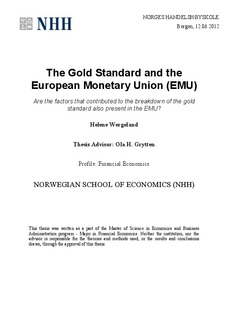The gold standard and the European Monetary Union (EMU) : are the factors that contributed to the breakdown of the gold standard also present in the EMU?
Master thesis
Permanent lenke
http://hdl.handle.net/11250/169553Utgivelsesdato
2012Metadata
Vis full innførselSamlinger
- Master Thesis [4372]
Sammendrag
This thesis seeks to identify the most important factors that contributed to the breakdown of
the gold standard in the 1930s, and to see if these factors are present in the European
Monetary Union (EMU) today. This is done in order to find out if the same factors might
create, or have created, similar instabilities and problems in the EMU as they imposed on the
interwar gold standard.
The factors regarded as important for the breakdown of the gold standard are (1) the central
bank´s interest rate policy and the rules of the game, (2) imbalances in exchange rates and
(3) debt levels, (4) the systems ability to handle fundamental changes, and the (5) credibility
of the monetary union.
Comparative methods have been used in order to find out if the factors are present in both
monetary unions. The countries to be analysed are in opposite positions within each union.
This is done in order to highlight the differences and instabilities.
The conclusions from the discussion are that there are similarities between the gold standard
and the EMU for all the five factors, and that they do impose instabilities also in the EMU.
Gold standard members interrupted gold flows as they failed to follow the rules of the game
in their interest rate decisions, while the EMU countries are unable to affect the capital flows
in the same manner because of their common interest rate. Differences in inflation and
economic development have caused the real exchange rates to diverge between countries,
affecting competitiveness and international trade. Also very high debt levels in some
countries have imposed problems in both monetary unions. But the origin of the debt and the
degree of future government obligations increase the severity of the debt levels in the EMU
compared to the gold standard.
Rigidities in wage and price levels impede the adjustment mechanisms within both unions.
This has extended the adjustment periods and made them relatively harder for the economic
activity as more pressure is put on output and employment in order to adjust. The lack of
cooperation and political integration has also reduced credibility in both monetary unions.
It is likely that these factors will continue to create problems within the EMU in the future,
but it is difficult to predict if they are going to cause the breakdown of the monetary union.
Compared to the gold standard, the EMU is already a more politically integrated monetary
union with free trade and labour agreements and a common independent central bank. This
could have made the EMU more resistant to the factors compared with the gold standard, but
the efforts seem to be inadequate.
